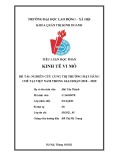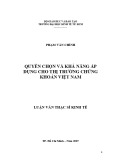
FOREIGN TRADE UNIVERSITY
INTERNATIONAL ECONOMICS FACULTY
…………..o0o…………..
ECONOMETRICS FINAL EXAM
TOPIC: FACTORS AFFECTING QUANTITY OF NEW CARS SOLD
FOREIGN TRADE UNIVERSITY STUDENTS
Class : K57 JIB
Lecturer : Ms. Tu Thuy Anh
Ms. Chu Mai Phuong
Group : 16
Members : Dao Thi Kim Linh - 1815520187
Mai Thanh My Linh - 1815520189
Nguyen Thi Ha Vy - 1815520239

HaNoi – 10/2019
Introduction
The market of car in US remains fiercely competitive from the beginning in
the late 1890s until now. Beginning in the 1970s, a combination of high oil prices
and increased competition from foreign auto manufacturers severely affected the car
companies in US. Therefore, it is necessary to investigate the car industry in the
period of time in 1970s to understand not only the car market but also the market
operation as a whole. In this research we want to investigate the six variables which
seem to have impact on the number of car in US from 1975 to 1990. This result can
contribute to the judgement on the car industry in US. Moreover, it helps to strength
the theory of the relationship between macroeconomic and microeconomic factors
and the quality of product sold.
The research has use the quantitative method and has the following structure:
Part 1: Data description
Part 2: Econometrics model
Part 3: Robustness check
Part 4: Result table

TABLE OF CONTENT
The research has shown the relationship between the six economic variables
and the quantity of car sold in US in the period of 1975 to 1990. From the
analysis results, it can see that only four variables including prime interest
rate, income, population and price has relationship with number of new cars
sold. The unemployment and number of cars on the road do not hold effect.
The income has the most impact on the number of car sold in a positive way.
Together with the price, income variable has the positive relationship with the
dependent variable. In contrast, the prime interest rate and the population has
a negative relationship with the number of car sold. ......................................29
However, when applying the result into reality, we found that population
variable does has impact on the number of new cars sold but the scale impact
did not as much as the result numbers told. This could come from the
drawback of our observations. The number of observations is small, the time
is restricted in fifteen years, the origin of the observations is not clear enough.
All these things could lead to some imprecise in our research result. ............29

I. Abstract
This research investigates the relationship between microeconomic,
macroeconomic variables and number of cars sold in US. The main objective is to
determine the factors that affecting the number of car sold in US. This research
covers the time period from 1975 to 1990. The analysis methods that have been
applied in this study include descriptive statistics, linear regression and correlation
analysis. The findings show that price, income have positive relationship with the
number of car sales in US, while the prime interest rate and population have
negative relationship with the number of car sales in US. The income has the most
influence on the quantity of car sold while the population has unreliable effect on it.
However, the gap in impact on number of cars sold among four factors is not huge.
The findings were consistent with the previous findings done by other researcher.
1

II. Literature Review
There are many researches that investigated the relationship between quantity
of car sold and its determined factors all around the world. Our research focuses on
the relation between number of car sold in US and six variables including Price
index, Prime interest rate, Income, Unemployment rate, Stock, Population. In the
research process, there are some studies which share the same common with objects
to our studies’. We present them here below.
In 2010, Faculty of Mechanical Engineering, Industrial Engineering and
Computer Sciences in School of Engineering and Natural Sciences University of
Iceland performed a study called The Effects of Changes in Prices and Income on
Car and Fuel Demand in Iceland. It examined the elasticities of demand for fuel and
cars in Iceland will be examined, both with a common classical reversible demand
model and also with an irreversible model, in order to examine asymmetric effects
from variables influencing the demands.
It constructed both reversible and reversible models for the demand of new cars
and then used regression analysis on these models. The econometrics results
showed that income has a great impact on the demand for new cars in Iceland.
Increase in income has much more effect on the purchase of new cars than the size
of the car fleet, which means that more new cars come into the fleet and more old
ones go out when income increases. So that the car fleet changes with increasing
income and consists more of newer and better cars that use less energy and are
better for the environment.
In 2012, Education University of Sultan Idris Malaysia did a research on
Automobile Sales and Macroeconomic Variables: A Pooled Mean Group Analysis
for Asean Countries. This paper analysed the impact of economic variables on
automobile sales in five ASEAN countries involving Malaysia, Singapore,
Thailand, Philippines and Thailand collecting annual data from 1996 to 2010. The
long term and short term correlation between these variables are implemented using
2



![Bài tập lớn phương pháp nghiên cứu khoa học trong kinh tế [chuẩn nhất]](https://cdn.tailieu.vn/images/document/thumbnail/2025/20250808/kimphuong1001/135x160/98171754624147.jpg)

![Thuế tiêu thụ đặc biệt: Bài tiểu luận học phần [chuẩn nhất]](https://cdn.tailieu.vn/images/document/thumbnail/2022/20221221/phuongyen205/135x160/9461671610587.jpg)




















